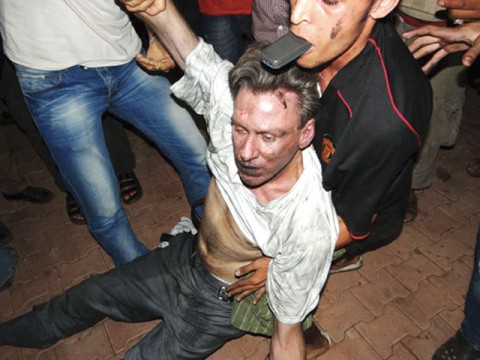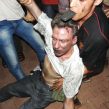
Hot Issue – Could Benghazi Embassy Deaths Be a Harbinger of Al-Qaeda’s “Fourth Generation Warfare”?
By:

This year, the anniversary of the al-Qaeda 9/11 attacks on the United States was marred by a series of demonstrations against American diplomatic missions, beginning in Egypt and quickly spreading to Libya, ultimately covering a band of Muslim communities from the United Kingdom to Australia. These demonstrations were triggered mostly by local manipulation of Muslim outrage at an offensive 14-minute English language trailer reportedly produced in California by a man on parole from prison. The film clip, badly produced and ridiculously acted with some of its more offensive parts dubbed in over the actors’ normal voices, would be ludicrous and almost entirely unknown if not for its inflammatory impact once it was provided with Arabic subtitles. There is no evidence that a central hand coordinated the demonstrations or that they represent the political views of all Muslims; however, the apparent upwelling of emotion among the diverse Muslim communities achieved the appearance of unity, at least for the moment, that al-Qaeda never achieved during Bin Laden’s lifetime. Al-Qaeda and its sympathizers are now attempting to take advantage of this rage.
The Attack in Benghazi: Varying Accounts
Of the many demonstrations, the most infamous was the attack on the American Consulate in Benghazi, which resulted in the tragic deaths of the U.S. Ambassador, three other American Embassy employees and a number of Libyan defenders. Early reports indicated that the attack came in two waves, the first simply a demonstration and the second, an organized guerrilla style attack carried out by men armed with RPGs, grenades, and assault rifles. Other accounts by Libyans who were present during the attack claim that the consulate suffered only one sustained, well-organized attack.
U.S. and Libyan accounts of the attack are not consistent. Contradicting early reports from anonymous U.S. officials, the current U.S. government analysis cites the lack of hard evidence that al-Qaeda was involved or that the terrorist attack was extensively planned. The Libyans disagree and have insisted that the attack by approximately 50 heavily armed men was premeditated and planned in detail by foreign elements. [1] Muhammad al-Megaryef, president of the Libyan National Congress (Libya’s legislature), stated that the attack on the consulate was planned by foreigners connected to al-Qaeda who had entered Libya some months previously to carry out "criminal acts." [2] Megaryef also stated that some of those arrested are from Algeria and Mali. On September 23, Libyan Interior Minister Fawzi Abdelal met with the head of the U.S. investigation team to consider outstanding questions about the attack. Among these questions were whether the attack was premeditated, whether the attackers received any assistance from al-Qaeda and how the attackers seemed to know the travel plans of the American diplomats as well as the location of a safe house near the consulate (Libya Herald, September 24).
It is necessary to separate the attack in Benghazi from other recent events. With the salient exception of jihadist groups, Libyans generally appreciate Americans even in fractious Benghazi. The consulate there does not house a large American contingent or offend the local residents. Benghazi, however, has been the site of previous attacks carried out by self-styled jihadist groups. Whether or not jihadist groups in eastern Libya have operational connections to al-Qaeda, some, like Ansar al-Shari’a, share al-Qaeda’s rigid, anti-democratic, anti-American global jihadist ideology.
The Blind Shaykh’s Mystery Battalion
Benghazi has also had its share of jihadist terror. On May 22, the International Committee of the Red Cross (ICRC) was attacked; on June 5 the American consulate was attacked; and on June 11 the British ambassador’s convoy was attacked. A previously unknown and still mysterious group known as the Battalions of the Prisoner Shaykh Omar Abd al-Rahman claimed responsibility for placing a small improvised explosive device near the gates of the consulate in retaliation for the death of prominent al-Qaeda leader Abu Yahya al-Libi, who was killed in a U.S. drone strike earlier this year (Militant Leadership Monitor Quarterly Special Report, July 2012). The same group attacked the local ICRC offices because of their alleged proselytization of the Muslim population. Nothing is known of this jihadist group beyond some communiqués posted on known jihadist websites and pamphlets left at the site of the early-morning bombing of the consulate. This group, if it ever existed as an entity distinct from Ansar al-Shari’a, does not seem large enough or capable enough of carrying out the September 11 attack.
The Libyan Government believes that Ansar al-Shari’a was responsible for the attack as it believes the group was responsible for attacks on other foreign interests and even on Sufi shrines in Libya that represent a milder, popular strain of Islam. Ansar Al-Shari’a is a militia of some 200 to 300 armed men. Ansar al-Shari’a is not a clandestine organization. It would make no sense, therefore, for the group to claim responsibility for terrorist acts against the United States because doing so would make retaliation a near certainty. On the other hand, if Ansar al-Shari’a had wanted to attack the consulate and maintain deniability, they would not have needed extensive planning before the attack; they had the weapons and the men and already knew everything they needed to know about the consulate because it is on their turf. The militia had what is in military parlance is called a cold-start capability in Benghazi. They would not have required help from al-Qaeda or anyone else to plan the attack. In this context, the search for a command to attack the American consulate in Benghazi is likely come up empty.
"We Are Ansar al-Shari’a"
In eastern Libya and elsewhere, we may be witnessing the rebirth of al-Qaeda’s ideas in new trappings. Even before Bin Laden’s death, al-Qaeda had become a brand, an idea and not an organization with a command-and-control system. Al-Qaeda strategists concluded that the international security system aligned against al-Qaeda after 9/11was too powerful to overcome with a traditional hierarchical system. The concept of fourth generation warfare – stateless, borderless and without defined military fronts – became intriguing to the jihadists. Bin Laden did not listen to this advice or only half-listened because he wanted to be in charge; but under the fierce pressure of the American drone war, the decimated organization became a system of regional franchises as well as decentralized groups and individual jihadis. The top leadership of al-Qaeda Central became icons of jihad that engaged in information warfare but, because of security considerations, could cajole but no longer command after the failure of al-Qaeda in Saudi Arabia in 2005/6.
As the global al-Qaeda system became more reviled than respected among Muslims, Bin Laden worried about the brand’s image. To succeed, al-Qaeda required Muslim communities all over the world to unite behind Bin Laden’s Salafi-Jihadist movement. The organization was weak, but the idea was still dangerous. All the Salafi-Jihadists needed to do was to stay alive, create chaos in weakened and failing states and aim for the next spectacular terrorist attack to prove they were still in the game. Then the Arab Spring erupted; U.S. Special Forces killed Bin Laden and a new era for al-Qaeda began. Subsequently a search for a new name or names for the enterprise began in the hopes that the West would not notice, so they could gather strength through activities in areas like eastern Libya from which many of the al-Qaeda lieutenants and soldiers had come in the first place.
A jihadi website with an extensive library of jihadist texts and communiqués, Minbar al-Tawhid wa’l-Jihad, is also a home to a repository of extremist fatwas that support al-Qaeda. One member of the Shari’a committee is Abu al-Mundhir al-Shanqiti, who once gave a legal opinion justifying the killing of U.S. ambassadors. Al-Shanqiti’s latest article, "We Are Ansar al-Shari’a,” provides the answer to the search for a better name for the jihadist enterprise, one that would resonate with ordinary Muslims. [3] Al-Shanqiti also rejects the term “Salafist” because it could be confused with Salafist political movements such as those in Egypt. These groups "do not wage jihad," he claims, adding that "they support tyrants" and "participate in democracy." Al-Shanqiti also rejects Salafi-Jihadist, a term al-Qaeda sometimes applies to itself. According to al-Shanqiti, "Salafi-Jihadist" is a true descriptor for the global jihadist movement because it distinguishes the true movement from all the “deviationist groups." However, al-Shanqiti states that the name may suggest that jihad is the only activity of the movement, when the movement has many other activities such as education, preaching, charitable works and others.
Al-Shanqiti claims that Ansar al-Shari’a has been out of the public eye for many years "because of the war, which this [American] system fighting the laws of Allah launched against them." However, now under the name Ansar al-Shari’a "they can return to the fields of action in many countries, such as "Egypt, Libya, and Jordan…" He states that Ansar al-Shari’a can be separated now and unify later because "they do not recognize current borders."
Conclusion
One might question whether the Ansar al-Shari’a in Libya is one of the groups described by al-Shanqiti as an alternative to al-Qaeda. It is certain, however, that Ansar al-Shari’a opposes the United States and all Muslim political parties, including conservative Salafist groups that participate in democracy. The Benghazi group fits al-Shanqiti’s description and could well be one of the new faces of an overt al-Qaeda. If no formal link to al-Qaeda is found in the attack on the U.S. consulate in Benghazi, it may be that there was no need for such a connection because al-Qaeda under its new name is already there hiding in plain sight. The group does not need an offensive film to be motivated to kill Americans. This is evidently what the people of Benghazi concluded before driving Ansar al-Shari’a from its facilities on September 21.
Dr. Michael W. S. Ryan is an independent consultant and researcher on Middle Eastern security issues and a Senior Fellow at the Jamestown Foundation.
Notes:
1. "Libya Determines that Approximately 50 Persons Participated in the Attack on the American Consulate in Benghazi" (in Arabic), Akhbar Libya Jadidah website, September 16, 2012.
2. "Megaryef: Approximately 50 individuals Arrested in Connection with the Attack on the Consulate" (in Arabic), DP News, September 16, 2012.
3. See al-Shanqiti’s Arabic page on the Minbar al-Tawhid w’ al-Jihad website: https://www.tawhed.ws/a?a=shanqeet. For different perspectives on Ansar al-Shari’a name, see: Joas Wagemakers, "What’s in a Name a Jihadi Labels Himself," Jihadica, September 11, 2012, and Aaron Y. Zelin, "Know Your Ansar al-Shari’a," Foreignpolicy.com, September 21, 2012.




